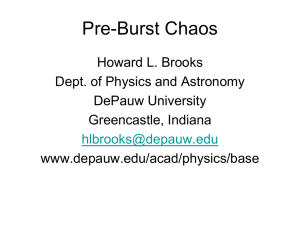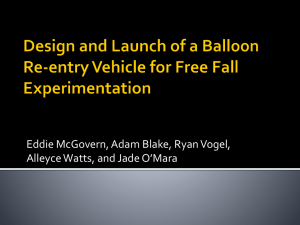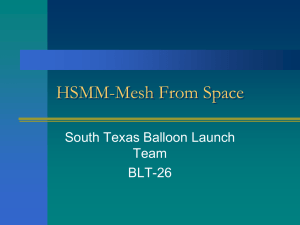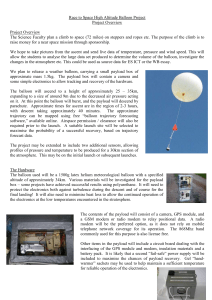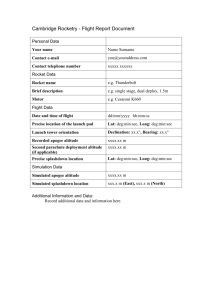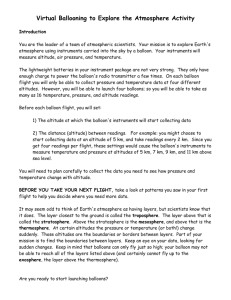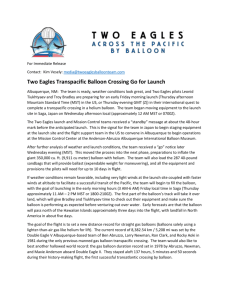The Latest Airship Technology From Near Space Corporation
advertisement
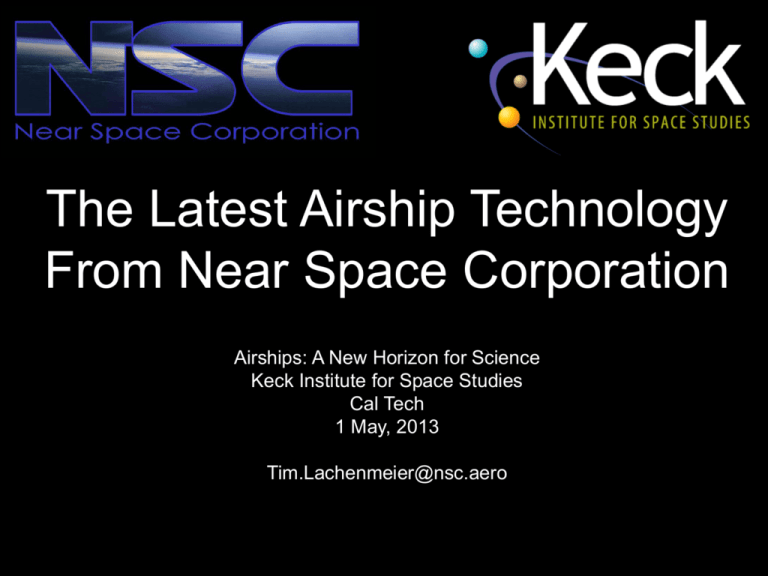
The Latest Airship Technology From Near Space Corporation Airships: A New Horizon for Science Keck Institute for Space Studies Cal Tech 1 May, 2013 Tim.Lachenmeier@nsc.aero Unpowered Airships, Tactical Balloons, Return Vehicles, and Some Good Places to Fly Airships: A New Horizon for Science Keck Institute for Space Studies Cal Tech 1 May, 2013 Tim.Lachenmeier@nsc.aero FOCUS Briefing Focus: • • • • HOW WHERE WHEN WHY Bridging The Gap To Space Lightweight Science Payloads on High Altitude Long Duration Balloons and Airships HISTORICAL NOTE Provider of Near Space Solutions LCANS 2009 - NCAR Mesa Lab, Boulder, Colorado SOME INITIAL OBSERVATIONS Bridging The Gap To Space - Lightweight Science Payloads on High Altitude Long Duration Balloons and Airships Everything is Relative: • Gap to Space • Lightweight (‘PongSAT’, 6 lbs, 80 lbs, 2000 lbs) • Science • High Altitude (60-70kft, 100kft, 130kft, 170kft) • Long Duration (2 days, 60 days, 100 days, several months, 744 days) • Balloons and Airships (weather balloons, polyethylene zero-pressure, polyethylene superpressure, zylon, re-usable multi-layer envelopes) LCANS 2009 - NCAR Mesa Lab, Boulder, Colorado SOME INITIAL OBSERVATIONS Bridging The Gap To Space - Lightweight Science Payloads on High Altitude Long Duration Balloons and Airships Everything is Relative…. Including: • Costs ($2,500, $100k,$3M, $25M, $200M+) • Performance (“let’s see what happens”, 95% success rate) • Schedule (few months, few years, “sometime during my career”) LCANS 2009 - NCAR Mesa Lab, Boulder, Colorado FOCUS OF PRESENTATION NSC’s Part of High Altitude Ballooning: • Background • Experience • Markets/Customers • Core Capabilities • Applicable Technology/Systems LCANS 2009 - NCAR Mesa Lab, Boulder, Colorado Space Defense Climate Concept Evaluation Technology Development MARKETS SERVICES CAPABILITIES Engineering • Design • Analysis • Integration • Testing Manufacturing • Prototyping • Fabrication • Assembly Flight Operations • FAA Coordination • Mission Planning • Balloon Flights CAPABILITIES Engineering • Specialize in custom inflatable, balloon, material, and mechanical engineering • Balloon design and analysis using custom tools and software • Flight train hardware design, testing, and certification • In-house testing capabilities • Materials characterization • Elevated and cold temperature testing • Altitude chamber testing (pressure, density, and temperature up to 130,000 ft std atm) • Hangar Inflation tests CAPABILITIES Manufacturing • Fabrication • Hot wheel, band, impulse, and RF sealers • Computer controlled and manual sewing machines • Assembly • On-site staff skilled in handling inflatable articles & vehicles Assembly / Inflation / Integration Versatile Sealer Technology CAPABILITIES Flight Operations • • • • FAA coordination, mission planning, & operations oversight Equipment on-site: 25 ton crane, service truck (“dually”) Tracking aircraft for airspace de-confliction, telemetry, filming, etc. Self Contained (air-conditioned) Mobile telemetry & command trailer Tracking Aircraft 25 Ton Crane Recovery Vehicles Self-Contained Mobile Command Center CAPABILITIES Flight Operations • Mission planning and tracking software • Trajectory forecasts and real-time monitoring • Portable situational awareness system • VHF GPS beacons and multi-target tracking software • Displays target locations on Google Earth • Tracks multiple air and ground assets simultaneously with continuous range, bearing, course and speed data • Stand alone units located in tracking aircraft, recovery vehicles, etc. NSC Telemetry Trailer Command Center NSC Mission Planning Software ESTABLISHED NSC LAUNCH LOCATIONS Tillamook, Oregon Madras, Oregon South Point, Hawaii Hawaii Launch Site Tillamook Airport Madras Airport TILLAMOOK FACILITIES WWII Blimp Hangar • 1,072 ft Long x 296 ft Wide x 192 ft High • Ideal for prototype inflation • Balloons inflated inside, moved out Tillamook Airport WWII Blimp Hangar • Low use, good for balloon launches • Blimp mooring areas for operations • Low population density area W-570 Special Use Airspace • 24 miles off coast of Tillamook • Ocean surface to 50,000 ft. • NSC is member of Western Air Defense user’s group (same priority as DoD members) Tillamook Airport W-570 NEW TILLAMOOK FACILITY – INTEGRATED OPERATIONS Highly Integrated Facility • Engineering • Production • Payload/Platform Integration & Testing • Currently completing construction (Initial Operating Capability Scheduled for April 2013) NEW TILLAMOOK FACILITY – AIRSIDE OPERATIONS Through the Fence Operations • Large Integration Hangar • Command Center/Observation Tower • Direct Access to Launch & Recovery Areas Johnson Near Space Center (JNSC) – Initial Operations May 2013 JNSC SITE Map New Flight Facility 100 Acre Launch Operations Area Existing Blimp Hangar Facilities MADRAS LAUNCH SITE HANGAR LAUNCH AREA Madras Airport, Madras, Oregon • 117 miles SE of Portland • Low-use public airport • Low use, good for balloon launches • Low population density area HAWAII LAUNCH SITE South Point, Hawaii • Island of Hawaii (“Big Island”) • 47 miles South of Kona • Moderate climate • Fly over open ocean • Moderate climate • Low population density area BIG ISLAND LAUNCH SITE LAUNCH FACILITIES COMMERCIALLY OFFERED NANO BALLOON SYSTEM (NBS) • Standard Service • Payload Mass:1 kg (2.2 lbs) • Payload Size: 10 cm x 10 cm x 10 cm (0.4” x 0.4” x 0.4”) • Services To Payload: Passive Payloads Standard • Float Altitude: Up to 30 km (98 kft) • Duration at Float Altitude: Up to 3 hours • Location: Tillamook, Oregon • Benefits: • Rapid Integration • Operates Under Minimal FAA Regulations • Offers Longer Duration than Neoprene Balloon NBS Polyethylene Balloon • Non-Standard Services • Greater Payload Masses • Higher Float Altitudes • Longer Durations at Float Altitude • Remote Launch Locations • Payload Thermal Insulating Containers for Different Payload Volumes • Command Signals and Onboard Data Storage NBS Avionics Housing NBS Payload Thermal Insulating Container COMMERCIALLY OFFERED SMALL BALLOON SYSTEM (SBS) Features: • Command, Telemetry, & Onboard Data Storage • Float Altitude: Up to and Beyond 35 km • Duration at Float Altitude: Up to 24 hrs • Standard Interfaces for Streamlined Integration • Payload User’s Handbook Available • Rapid Payload Change-Out for Rapid Re-Flight SBS Prototype Flight – Nighttime Launch Time (seconds) vs. Altitude (m) of Example SBS Mission SBS Avionics Housing RECENT NASA FOP NMT SBS FLIGHT NASA Flight Opportunities Flight for NMT: • Flown 20 January 2013 from NSC Madras Launch Site • New Mexico Tech Payload • Payload Sponsored by FAA AST (Commercial Space) • Flight Sponsored by NASA OCT FOP • Prototype Technologies for Structural Health Monitoring • Provided relevant environment (~101,500 ft) • Float Duration (~1hr) • Multiple Experiments NMT SBS PAYLOAD CHECKOUT NMT SBS FLIGHT TRAIN (Post Launch) NMT SBS PAYLOAD (Post Landing) HASS Hybrid Platform – Stratospheric Balloon/Return Vehicle Stratospheric Operations Tactical Launch Payload Return Demonstrated HASS Capabilities 10+ kg payloads • Shuttle has been demonstrated w/ 15 kg science payload • Tactical launch system currently handles up to 45 kg (w/ parachute recovery instead of glider) 20-30 km altitudes • Up to 40 km possible with custom balloon envelope & larger launch bag 6 to 24+ hour flight durations • Extended time at altitude • Ballast required to fly through sunset Streamlined operations • Flexible Payload Bay Provides Easy Integration • Rapid Payload Changeout • Launched with 3 man crew in up to 30 kt winds • Autonomous flight and landing capability • Radar/RF Transparent Shell • Non-turbulent Flight Environment High-speed Descents • .8 Mach max design speed (have demonstrated transonic flight) Autonomous Return and Landing COMPANY HASS HISTORY Persistence Persistence Through Constellation Replenishment • Platform uses tactical balloons which allows: • Launch in up to 30 knots from austere location and minimum launch crew • Altitude tuned immediately prior to flight for best duration over target (slowest wind speeds) • New platform is launched to maintain desired effect • Multiple platforms can provide spatial observations and provide line of sight data relay NSC WindStar Balloon Technology Long Duration – Altitude Control • • • • • • NOAA GAINS Program (Planned for a Constellation of 400 platforms) Global Capability Can Modify Flight Trajectory (via Altitude Control) Up to 150kg Payload Up to 80kft Altitude 100 day duration NOAA Smart Balloon Composite Spectra Shell, Polyethylene Bladder and Polyurethane Helium Cell (Based on NSC Windstar Technology) • Iridium C3 System • Battery Powered Pump • Low Altitude Tracer NSCDRIFTSONDE EXPERIENCE Driftsonde Balloon Platform • Stratospheric balloon lifts 50+ sounding devices to ~100 kft • 23 Launched from NSC Hawaii Facility as part of TPARC • Balloon drifts over Pacific toward Southeast Asia • Sounding devices (dropsondes) drop to measure temperature, pressure, moisture, position, time, and velocity Driftsonde Balloon Inflation • Partnership with NCAR, (part of NSF) & CNES (French space agency) • In situ measurement data used to create more accurate weather models, validate satellite data Dropsonde STRAT Stratospheric Reconfigurable Airship Testbed (STRAT) • • • • • • • Expendable – Mission Customized Envelope Powered Payload Return Vehicle Hangar Inflated and Tested Multi-day Duration Relative Persistence/Maneuverability <100kg to <80kft NDA required to learn more NSC Proprietary WHEN When? • • • • • Most stuff off the shelf or within a few (couple) months HASS – flying end of May from Tillamook Tactical Balloons – >75lbs on the shelf Windstar systems 3-6 months STRAT – 12 to18 months for initial demo (pending funds) CONCLUSION Questions? Tim Lachenmeier, PE President Near Space Corporation Tillamook Flight Facility (503) 842-1990 office (503) 816-2196 mobile Tim.Lachenmeier@nsc.aero
